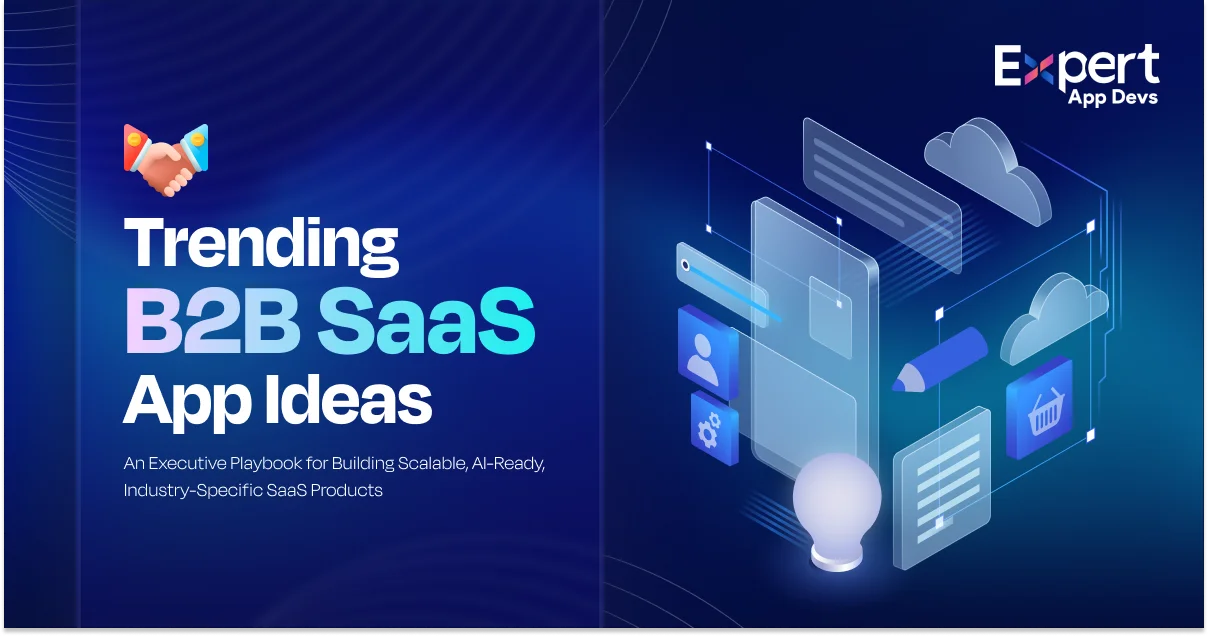Top B2B SaaS App Development Ideas for Startups in 2026
We are at the tipping point of a massive transformation in the B2B SaaS segment. From $232 billion to a projected $1.13 trillion by 2032, the SaaS growth is unstoppable. Additionally, with 95% enterprise tech budgets prioritizing AI-backed solutions, this has opened up new avenues for your business.
AI integration, vertical SaaS platform consolidation and business process automation are the core growth drivers of this industry. Top business platforms will reduce IT fatigue, drive ROI, automate processes and adhere to compliance guidelines.
With the need for intelligent and integrated platforms that can reshape the playing field, there is a window of opportunity for Business-to-Business Software as a Service companies in 2026. In this article, we will share with you the numerous SaaS business ideas that can help you build next-gen business tools.
2026 B2B SaaS Market Landscape & Growth Signals
You may notice that the B2B SaaS landscape is experiencing a dynamic transformation with a projected CAGR of 13.7%, estimating the market value to reach $829 billion by 2031. The United States and the UK are dominant players in this segment, while the Middle East, especially the UAE and Saudi Arabia, along with Europe, are steadily growing.
Enterprise environments are rapidly shifting. At least 60% of the IT teams in an enterprise are overwhelmed by manual operations, calling for streamlined workflows with automation. Moreover, 41% of these organizations want to consolidate their tools and platforms that can help them stay efficient and ensure cost control.
You may notice that the demand side has evolved with newer buyer expectations. Today’s C-level executives don’t want generic solutions; they need evolved and AI-native solutions that offer plug-and-play to deliver immediate value to the users.
Evolving global trends, newer pain points and strategic buyer demands have increased the opportunities for businesses in the B2B SaaS space. If you address these needs of your consumer in 2026, you will be at the forefront of this high-value market.
High-Growth B2B SaaS App Ideas for 2026
If you want to stay ahead in this trillion-dollar SaaS race, you can use these high-impact B2B SaaS startup ideas to solve the immediate enterprise challenges that deliver lasting value.
✅AI-Powered Vertical SaaS App Ideas
Enterprises are moving towards hyper-specialized solutions, which is why incorporating AI-backed vertical SaaS solutions can unlock operational efficiency for you. Let’s look at some of the top ideas.
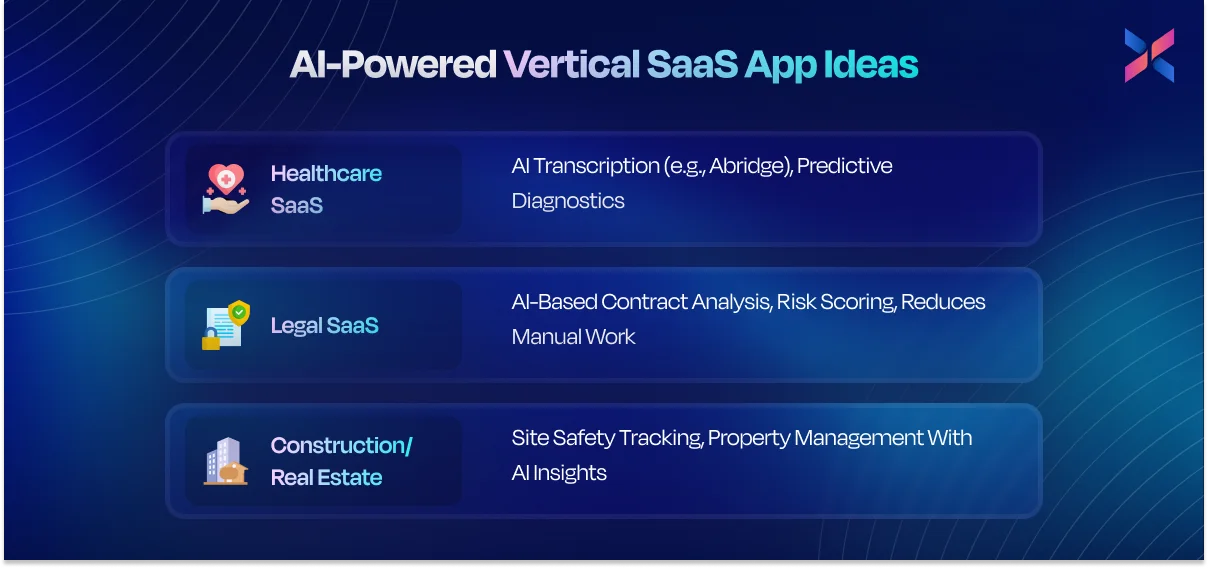
#1. Healthcare SaaS
By building AI-backed SaaS tools for the healthcare segment, you can streamline the clinical workflows while reducing burnout. It can also help enhance patient outcomes. For example, the Abridge app uses AI to transcribe the conversations between the patient and the doctor, thus saving hours that go into post-visit documentation.
You can expand on this example application to build next-gen tools that integrate EHR, auto-summarize the patient’s case history and identify early signs of diseases with predictive diagnostics.
Healthcare SaaS app development can help adhere to compliance while offering impactful value to enhance patient care. You can also use voice commands and AI-backed treatment recommendations for personalized treatments.
#2. Legal SaaS
Most legal professionals using manual methods tend to spend countless hours reviewing their contracts. With AI-backed legal SaaS systems, you can automate the entire process of contract analysis and flag risk clauses. These systems can also help legal professionals by offering intelligent suggestions using precedent or regulation.
Professionals can reduce their workload by up to 40%, thus focusing on strategies and core tasks. For example, you could consider building a vertical SaaS for solutions like Kira Systems that specifically work for SMB law firms.
By adding features like audit trails and AI-backed clause libraries, you can ensure cost efficiency and legal transparency.
#3. Construction/Real Estate
If you are in the construction or real estate industry, you can adopt AI to boost safety and enhance project oversight. AI-backed SaaS app development site safety tracking and property management with AI insights allows you to track compliance with camera feeds and IoT data, thus alerting managers regarding risks. AI can also optimize maintenance schedules and predict tenant churn.
OpenSpace is one such system that offers a tailored offering specifically for mid-sized firms. It provides ESG compliance and smart reporting. With the right features, you can reduce liability and deliver measurable value for asset management.
✅Hyper-Automation & No-Code App Ideas
With enterprises going minimalist, using fewer resources to accomplish more, no-code platforms are gaining popularity. With these solutions, non-technical users can automate repetitive tasks while reducing dependency on IT teams.
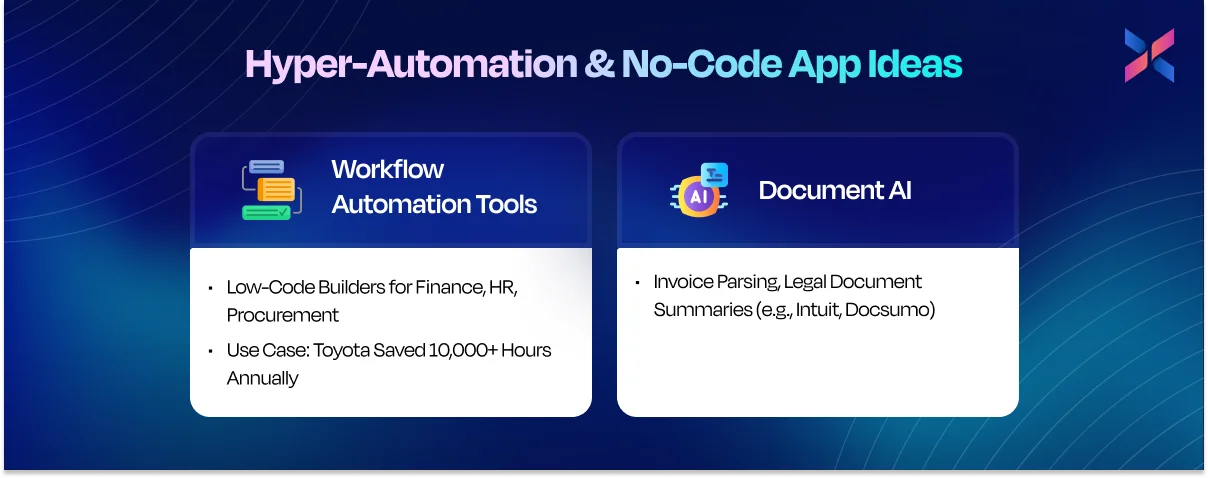
#4. Workflow Automation Tools
Finance, HR and procurement teams will experience massive transformation owing to the low-code workflow automation tools. With these platforms, you can enable the teams to build approval flows, integrate the different systems and reduce bottlenecks without the need for IT teams.
For example, Toyota was able to use these tools to save 10000+ hours annually to streamline internal processes. You can build next-gen SaaS tools that provide industry-specific templates with pre-built integrations and AI-specific logic builders. They can even help non-tech teams to create robust workflows.
There are diverse opportunities in the marketplace that can simplify the everyday operations for mid-market enterprises.
#5. Document AI
When your team works with document-heavy workflows, it can lead to maximum inefficiency across industries. SaaS business ideas like document AI can automate invoice parsing while extracting data from contracts and summarizing complex legal documents.
There are examples like Docsumo and Intuit that provide AI features to enhance the solution. You can build specialized vertical apps like these to enhance logistics, legal and healthcare industries.
You can use fine-tuned models, OCR and auto-validation to reduce manual entry and error rates. This SaaS idea can transform the back-office work to fewer clicks, thus saving time and compliance issues.
✅Industry-Specific ERP/Management Suite App Ideas
Modern enterprises are looking for intelligent and end-to-end platforms that manage their industry’s specific needs. Verticalized ERP with operations suites backed by AI and real-time data can help you stay competitive.
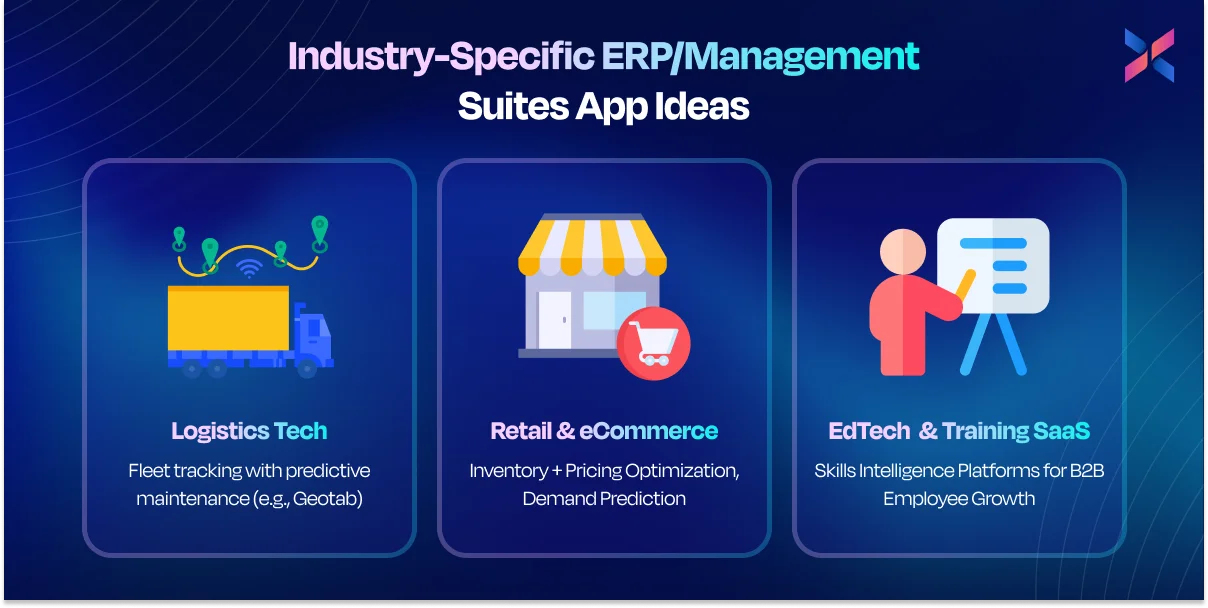
#6. Logistics Tech
Real-time visibility, along with uptime, is crucial for the logistics industry. When you incorporate a vertical SaaS platform that provides fleet tracking and predictive maintenance features, it can prevent breakdowns and reduce fuel costs. Eventually, it can improve delivery timelines.
There are tools like Geotab that help get the desired ROI by using AI-backed engine diagnostics and route optimization.
If you want to build on this SaaS idea in 2026, you may want to consider mid-market transport companies that need access to real-time driver behaviour and compliance alerts. You can also implement ESG dashboards with carbon tracking in these systems for sustainable scaling.
#7. Retail & eCommerce
There is constant pressure on retailers to optimize the stock, pricing and promotions in real-time. There are SaaS business ideas that combine AI-backed inventory management, dynamic pricing and demand forecasting to boost margins while reducing overstocks or stockouts.
You can use these SaaS ideas as a smarter Shopify backend to pull in the data from POS, marketplaces and customer behaviour. These systems can also help with A/B pricing tests, seasonal adjustments of inventory models and real-time restocking alerts.
Such tools can help you gain a competitive edge in the wake of supply chain volatility and rising customer expectations.
#8. EdTech & Training SaaS
Several enterprises are investing in upskilling their employees. However, they use generic LMS platforms that fail to deliver high-impact outcomes. There are skills intelligence SaaS systems that can help map the internal talent gaps while personalizing the learning paths.
These systems can also integrate with performance metrics to empower the enterprise’s HR and L&D leaders to build future-ready teams. These systems can also help teams with AI-backed role-fit analysis and promotion readiness scores. Additionally, these platforms are customized to suit the needs of tech, finance and manufacturing firms. These SaaS ideas will disrupt the industry as retention and upskilling are priorities for enterprises.
✅Trust, Risk & Compliance Ecosystem App Ideas
Enterprises must conduct regulatory audits to ensure they are aligned with ESG goals. That’s why trust-focused Software as a Service ideas are gaining popularity. These platforms help with carbon reporting and financial compliance by creating a secure and auditable ecosystem. Let’s look at some of the top ideas in this vertical.

#9. ESG & Carbon Tracking
As ESG regulations are growing stricter, companies must monitor, report and reduce their carbon footprints. We can build a SaaS platform that provides real-time emission intelligence dashboards to help these enterprises track their scope 1-3 emissions. These systems can also help them set targets and stay audit-ready.
You can use existing tools like Prewave and Watershed to inspire your designs and build systems that integrate with IoT devices and the supply chain to auto-generate your ESG reports.
By implementing features like benchmark comparisons and regulatory alignment by region, you can ensure the enterprises stay compliant and credible.
#10. Blockchain for Finance
Enterprises are increasingly concerned about financial fraud, audit trails and data integrity. When you build a blockchain-based SaaS system for tamper-proofing invoicing and regulatory reporting, it can ensure transparency and traceability.
These systems are built on a secure ledger and can automate different aspects like real-time audits, automated invoice validation and global compliance mandate adherence.
Such SaaS ideas can help manufacturing, logistics and global trade minimize manual errors while eliminating invoice disputes. We can merge fintech innovation with compliance assurance for regulated cross-border operations.
#11. AI for Compliance
The constantly evolving regulation landscape includes GDPR, HIPAA and ISO 27001 helps you stay compliant across industries. We can build an AI-backed compliance monitoring platform that helps analyze the data flows in real-time and flags potential violations.
It also offers proactive guidance before causing issues. For example, these systems can detect unauthorized access to patient data or immediate notification of non-compliant data retention practices.
You can integrate an enterprise software stack and provides role-based alerts, audit trails and region-specific compliance maps. This tool can also ensure reactive risk management with predictive compliance. These systems are perfect for legal, HR and IT leaders that need smart governance.
✅Executive & Finance Intelligence App Ideas
Static dashboards don’t fulfill the needs of a C-suite leader. These leaders require intelligent systems that can forecast outcomes and keep teams aligned.
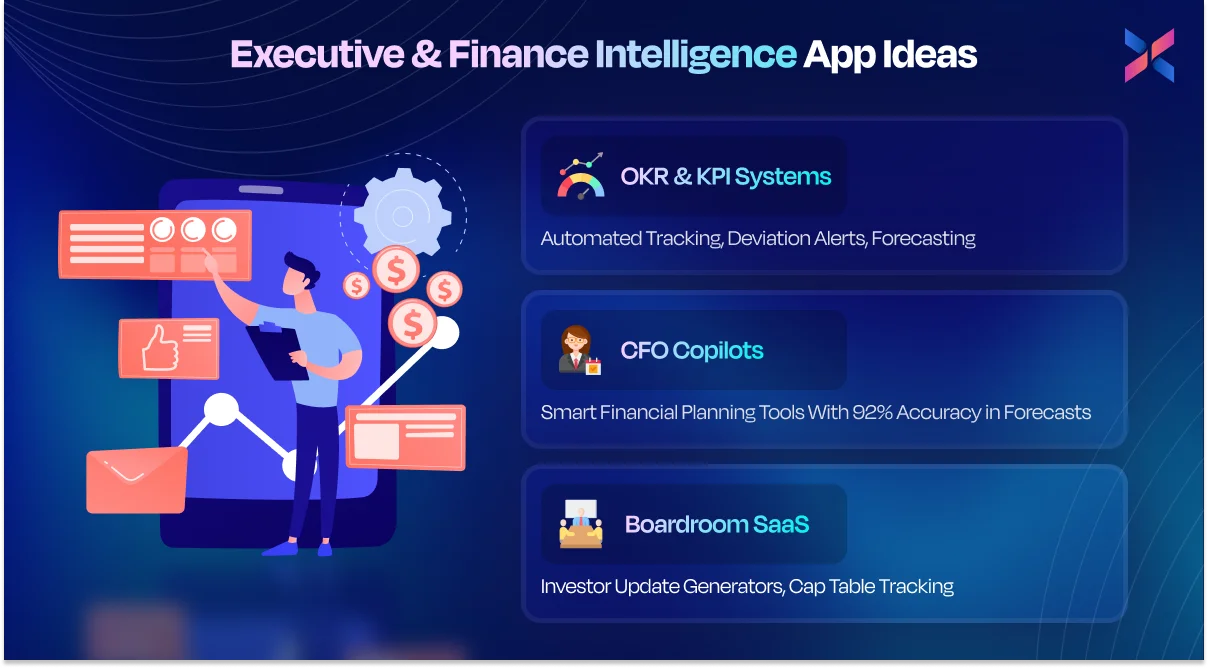
#12. OKR & KPI Systems
Traditionally, OKR systems are static and are completely disconnected from your daily operations. Using a modern SaaS platform, companies can automate KPI tracking, provide real-time deviation alerts and offer predictive goal forecasting. These SaaS systems can turn OKRs into a data-driven strategy tool.
These systems can pull data from all internal systems like CRM, ERP and HR so that the leadership gets alerts whenever the targets are off track. By including features like cross-functional goal mapping, trend analysis and AI-backed adjustments, you can ensure these systems are ideal for scalable companies and enterprises.
#13. CFO Copilots
Picture this - you are a CFO juggling between different aspects like planning, budgeting and investor reporting using limited tools. By embracing SaaS ideas as copilots backed by generative AI and real-time financial models to deliver forecasts with 92% accuracy. It can also help reduce the time spent in spreadsheets.
Using these systems, teams can automate the P&L projections, detect the financial anomalies and simulate the business impacts. By integrating with accounting software, you can turn cash flow analytics into financial strategies. This will empower finance leaders to move from reactive reporting to forward decision-making.
#14. Boardroom SaaS
Within an enterprise, communication between board members and investors depends on manual methods and fragmented processes. With the boardroom SaaS platform idea, you can automate investor updates and visualize cap tables. It can also ensure that board documents are compliance-ready.
AI summarization allows the founders and CFOs to generate monthly reports. Real-time cap table tracking provides transparency. With integrated document vaults, stakeholder permissions and a board voting module, you can create a one-stop governance solution. The system is useful for startups and scalable enterprises.
✅Sustainable Technology App Ideas
Sustainable isn’t an option for enterprises; it is a competitive and regulatory necessity. B2B SaaS ideas can help enterprises reduce their energy use.

#15. AI Energy Optimizers
Enterprises are looking at smarter methods to manage their energy costs and reduce their carbon impact. With an AI-backed energy optimizer SaaS startup idea, you can integrate smart grid infrastructure that helps analyze power usage, predict demand and auto-adjust the consumption patterns.
It is ideal for factories, campuses and data centres. By using machine learning, you can enable savings opportunities, suggest load shifts and monitor ESG targets in real-time.
When you merge IoT data with weather patterns and operational inputs, you create energy efficiency with reliability.
#16. Circular Economy SaaS
As a large manufacturer, you are pressured to reduce waste emitted from your company and embrace circular practices. For this, you must build a circular economy SaaS platform to track asset lifecycle and monitor material flows. It also helps optimize the reuse and recycling of supply chains.
This tool offers complete visibility into wastage and the opportunities available to deliver high-impact value. They should include features like material passports, carbon savings calculators and supplier network integration. This platform can provide a measurable and manageable business strategy.
Technical Framework for Scalable B2B SaaS Apps
When building future-ready SaaS products, you must ensure a solid technical foundation that supports scalability, security, intelligence and agility. Let’s take a look at the core elements that drive resilient and enterprise-grade SaaS architecture.
#1. Architecture
To build scalable B2B SaaS applications, you must invest in cloud-native and multi-tenant architecture with modular design for rapid customization and deployment. By using microservices, you can ensure that these features evolve independently without disrupting the SaaS system.
GraphQL is a tool that allows flexible and efficient integrations, which is essential for an enterprise environment with diverse data requirements. This architecture will support versioned APIs, CI/CD pipelines and high availability.
Adding this architecture can reduce the costs. When you add a containerized environment, you can make your SaaS platform agile, secure and suited for global rollout.
#2. AI Layer
Enterprise users need intelligent and context-aware features in the SaaS systems. By embedding large language models, such as OpenAI, Gemini and Cohere into the SaaS layer, you can enable natural language interactions, smart recommendations and document analysis.
When you use tools like Google Vortext AI and LangChain, it is easier to integrate prompt engineering and vector search. There are use cases like auto-summarization, user intent prediction and conversational dashboards for this SaaS system.
By implementing proper guardrails and usage controls, the AI layer can convert your traditional SaaS system into dynamic copilots to help you differentiate your business.
#3. Compliance-Ready Templates
Enterprise buyers need platforms that are secure and easy to audit. By investing in architecture comprising in-built templates and policies aligned with GDPR, SOC2 and HIPAA standards from the start.
You can add encrypted data pipelines, access controls, audit logs and role-based permissions. By implementing compliance-ready modules like DPA templates, breach notifications and region-specific data residency controls, you can shorten onboarding cycles and accelerate trust.
These templates can help industries like healthcare, fintech and global manufacturing.
Go-to-Market (GTM) Strategy for B2B SaaS App Development
Building a great product is not enough; you need to ensure maximum traction. Align pricing, sales and trust with your GTM plan, and you can meet the expectations of enterprise buyers.
#1. Pricing Models
This is an important aspect when planning the GTM strategy for your SaaS startup idea. Enterprises are looking for pricing that scales with value. You can provide usage-based billing that allows your customer to pay based on their consumption. It is useful for AI usage, API calls and user volume.
When you layer it with ROI-sharing tiers, it links pricing to results, thus creating a performance-aligned trust. By providing free trials, modular pricing and overage-friendly terms, you can build adoption with a de-risking commitment.
By implementing transparent calculators and quarterly ROI reviews, you can ensure pricing that helps improve retention.
#2. Sales Strategy
You can begin your sales strategy with a 3-5 enterprise pilot to refine the offering, build testimonials and validate the ROI. If you implement it along with a bottom-up strategy, you can engage the mid-level users with freemium or trials. This would improve adoption internally.
You can even use LinkedIn-based ABM strategy to target the decision makers with relevant content. Using methods like webinars, whitepapers and solution briefs for specific pain points can also enhance your sales. You should even consider creating a dedicated success team around the pilot client to create case studies with secure referrals.
With this hybrid GTM motion blend, you can ensure a product-led growth that is ideal for SaaS in regulated industries.
#3. Certifications & Trust Signals
Your enterprise clients need proof to establish security and governance. It is crucial to include certifications like ISO 27001, SOC 2 and zero trust architecture for your SaaS system. You can even provide complete ESG disclosure integration for the system’s architecture.
You can showcase third-party penetration test results, data encryption standards, uptime SLAs and customer data ownership policies in these systems. You can even add trust badges on the site, publish whitepapers and make a data protection officer accessible for increased sales.
With these signals, you can speed up procurement cycles and remove the key barriers for security-conscious deals.
#4. Retention Tools
As soon as the user logs into your system, you should begin investing in retention. You can provide interactive onboarding, contextual walkthroughs and task-based product tours that are customized for the user roles.
When you include real-time AI support, have training documents and analyze user behaviour, it can reduce the friction and improve time-to-value. It also proactively nudges the users with tooltips, milestone trackers and usage insights.
By monitoring their engagement metrics, you will know when they are likely to churn. It can also help build user communities and in-product feedback loops that ensure the roadmap is aligned with your users’ needs.
B2B SaaS App Development Execution Roadmap for 2026
Execution is a crucial part of converting your SaaS idea into an application. Using this phased roadmap outline, you can go from idea to enterprise adoption by aligning your product, infrastructure, AI and GTM. This will help deliver an incredible B2B SaaS solution in 2026.
Stage 1: Define niche → build MVP → pilot with early enterprise adopters
The first step is to identify the high-impact niche with clear pain points and measurable ROI. This will help build a lean, AI-capable MVP that is tailored to the particular industry. You can onboard 3-5 early adopters for your pilot program, co-develop the features and validate the outcomes. This stage focuses on tight feedback loops with proof of value and market fit.
Stage 2: Add AI layer → implement scalable infra → gather testimonials
When you layer the system with intelligence using LLMs, recommendation systems and prediction engines. You can then upgrade the system to a scalable infrastructure that is multi-tenant and containerized. Early users notice value, and are your first few success stories. These assets can help you build social proof for the system while refining the pricing. It can also prepare your sales team for a broader outreach.
Stage 3: Launch full GTM → scale marketing ops → expand integrations
In this stage, you will activate your GTM strategy, such as bottom-up adoption, LinkedIn ABM and content campaigns. You must use a verticalized marketing engine while you expand the integrations with enterprise tools. This is your momentum phase that is designed to drive adoption and improve brand awareness.
Stage 4: Launch AI-overview content hub → get listed in partner marketplaces → optimize for AI search experiences
You should publish the content hub that showcases how your platform can use AI to grant intelligent outcomes. Include case studies, interactive demos and ROI calculators in this part. You can also enlist the tool on marketplaces like AWS, Azure and G2 for visibility.
Make sure to optimize content and metadata for AI-backed search that enhances future-proof discoverability in the enterprise buying journey.
FAQs for Decision Makers Who Want to Build a B2B SaaS App
Q1: What are the most promising B2B SaaS app development ideas for startups looking to innovate in 2026?
A: AI-backed solutions, vertical SaaS solutions for industries like healthcare, logistics and legal, as well as hyper automation platforms can be considered for 2026. SaaS startups can also explore ideas like predictive analytics and cybersecurity applications. You can ensure stronger ROI with operational efficiency and better decision-making to drive value.
Q2: What critical factors should C-level executives consider when evaluating new SaaS startup ideas for investment or adoption?
A: As an executive, you should assess the startup’s ability to drive tangible outcomes like cost savings, revenue generation potential and operational improvements. Apart from this, you should also consider the scalability of your infrastructure, integration abilities with existing tools, market timing and defensibility as well as security compliance. It is equally important to consider the long-term viability and support structure extended by your vendor.
Q3: How does effective SaaS App Development contribute to a company’s digital transformation goals?
A: SaaS app development enables rapid cloud-native adoption, process automation and improved decision-making. It also reduces the barrier to innovation while reducing the IT overheads to accelerate digital maturity.
Q4: What are the key trends in the software as a service idea that will shape enterprise operations in the next 3–5 years?
A: AI-backed predictive systems, vertical SaaS platforms and composable architecture are some of the key trends to incorporate in your SaaS system. You can also use trust-enhancing technologies like Blockchain. With an emphasis on data compliance, performance visibility and modular platforms, you can scale your SaaS tools.
Q5: How can we ensure a SaaS App Development project is optimized for global target audiences?
A: You can ensure the SaaS app development project is optimized for top global target audiences like the USA, UK, Canada, Australia, the Middle East and Europe by designing for multilingual UI/UX, adhering to local regulations like GDPR and CCPA, and adjusting the design aesthetics for cultural norms. You should also use AI-logic that is region-aware, along with regional billing and supported workflows.
Q6: What is the typical cost range for B2B SaaS app development in 2026 by region?
A: Costs vary significantly by GEO due to labor, compliance, and infrastructure differences:
|
Region |
Typical Cost (USD) |
Notes |
|---|---|---|
|
USA |
$150,000 – $500,000+ |
High quality, enterprise-grade, fast delivery |
|
UK/Western Europe |
$130,000 – $400,000 |
GDPR-ready, high compliance, moderate timeline |
|
Canada |
$120,000 – $350,000 |
NAFTA advantages, talent access, bilingual support |
|
Australia |
$110,000 – $300,000 |
Focused on regional compliance and scalability |
|
Middle East (UAE, KSA) |
$90,000 – $250,000 |
Increasing demand, local cloud/data laws |
|
India & South Asia |
$45,000 – $150,000 |
Cost-effective, world-class engineering talent |
|
Eastern Europe |
$60,000 – $180,000 |
Strong security + delivery value balance |
✅ Tip: By outsourcing to regions like India or Eastern Europe, you can reduce costs by up to 60% without compromising quality.
FAQs for First-Time Founders Starting a B2B SaaS App
Q7: What is a B2B SaaS App in Simple Words?
A: A B2B SaaS app is a software application or tool that is developed for specific business needs to improve business operations like sales, support, CRM, etc. It is accessed via the internet as a subscription.
In simple words. B2B means business-to-business; hence, the app is made for businesses, not for individuals. Saas means software as a service; hence, rather than installing the software, it's used through the internet without downloading.
Q8: What Is B2B SaaS App Development?
A: B2B SaaS development is about building software that solves day-to-day problems of businesses. Its process involves: designing, building, and launching, similar to creating a mobile app.
It is sold on a monthly or yearly subscription to business users and organizations.
Q9: What Do I Need to Consider Before Starting My B2B SaaS Idea?
A: If you are planning to create a B2B software, then here are some things you must consider before getting started with your idea.
- What business issue does your app solve?
- Know who your users are and what other apps they already use.
- Start with developing a simple MVP (minimum version).
- Decide on your business model (monthly/yearly pricing).
- Always go for scalable development if you plan for the long term.
- Prioritize data privacy and user experience, on an important note.
Q10: What’s the Minimum Budget Required to Build a B2B SaaS App?
A: You must expect $25,000 to $75,000 as a minimum budget if you are planning to build a B2B SaaS app. Though the price varies according to complexity, scope, strategy you use, and many other factors. To give you more clarity, consider below.
- Micro SaaS app: $10,000 to $15,000
- Basic SaaS app: $30,000 to $35,000
- Average SaaS app: $50,000 to $60,000, and a complex SaaS app can go up to $140,000 to $150,000.
✅ Tip: You can start by creating an MVP and increase development by reviewing performance.
Q11: What Kind of Team Do I Need?
A: Here is the list of professionals you would need to create a B2B SaaS app.
- 1 Product Manager (vision and planning)
- 1 UI/UX Designer
- 2–3 Developers (frontend, backend)
- 1 QA Tester
- 1 DevOps (cloud hosting, deployment)
- Optional: CTO or SaaS Consultant
✅ Tip: If you don’t want to hire a full in-house team, you can also partner with a B2B SaaS development company that already has this team.
Q12: How Can I Sell or Rent My SaaS Product Properly?
A: To allow more and more people to use your SaaS product, here are some of the smart ways.
- Offer free trials or freemium access so they can see the value.
- Provide multiple pricing models like basic, pro, and enterprise. Hence, users can choose whatever fits their budget.
- Create a simple website with your product demos, features, and real success stories.
- Partner with resellers or agencies.
- Promote your product through content marketing strategies, blog posts, LinkedIn, etc.
Q13: What Checklist Should I Follow So My Product Doesn’t Fail?
A: Follow the checklist below if you don't want to fail your SaaS product idea.
- Validate the idea by talking with real users before building.
- Build only the key features first (MVP) that solve the user's issue.
- Test MVP, collect user feedback, and improve the product based on that.
- Keep the interface simple and business-friendly(even for non-tech users).
- Invest in cloud security to protect users' data.
- Start marketing to create awareness and demand for the product.
- Track key metrics like usage, engagement, and drop-offs.
- Provide great support.
Q14: What If Someone Copies My SaaS Idea With a Bigger Budget?
A: The app idea is precious, and you must protect your idea from the day you decide to implement it. Here is how you can do that.
- Trademark your brand name and domain.
- Have a unique angle, such as a specific niche, smart price, user experience, etc.
- Build a loyal early user at the early phase.
- Speed up your development process than your competitors.
- Add more value through services, integrations, and customer support.
Q15: How Long Will It Take From Idea to Launch?
A: It depends on how big your saas idea is. Basic MVP version can take over 3-6 months. While if you go for building a full product with marketing, sales setup, and everything. It can take over 6 months to a year or more.
Q16: How Do I Get Investors for My SaaS App?
A: To attract investors, you need to show that your idea is real and has potential. Here’s how:
- Create a strong pitch deck that clearly explains the problem, your solution, the target market, your plan, and a quick demo.
- Show some traction—even a few paying users or sign-ups.
- Use platforms like AngelList, Crunchbase, and LinkedIn to find and connect with investors.
- Apply to startup accelerators like Y Combinator or 500 Startups—they can help with funding and guidance.
- Attend tech events and network—warm introductions and casual meetups can work better than cold emails.
Q17: How Can a Partnership or Tie-Up With Other Companies Help Me?
A: Partnerships with the right companies can give your product great exposure.
- They can resell your app by referring to others.
- It will boost your credibility and reach.
- Provide co-marketing or tech integrations (like webinars, blogs, or bundles)
- Help with enterprise deals or joint ventures.
Q18: How Do I Pitch a Company for a Tie-Up?
A: Before pitching to any company, understand what the company does and how your SaaS product can add value to them.
- You can reach them through email or LinkedIn with a friendly message.
- Show them how this partnership will benefit both.
- Share a short product demo via email.
Here is a sample to pitch a specific company:
“I’m [Your Name], founder of [Your Company Name], a B2B SaaS platform that helps [brief value proposition – e.g., “automate team onboarding and reduce manual HR tasks by 60%”].
I came across [Their Company Name] and noticed we both serve a similar audience. I believe there’s a great opportunity for us to collaborate.
Can we set up a 20-minute call to discuss?"
Q19: What Makes a B2B SaaS App Successful Long-Term?
A: If your SaaS product is adding value to the customer’s life and business, they are likely to pay for it and use it for the long-term.
- If it solves a real business pain
- Simple, fast, and easy to use
- Scalable and secure in the cloud
- Great support and onboarding
- Constant user feedback and improvement
Q20: Can I Start with Just an Idea and No Coding Knowledge?
A: Yes, most of the founders who run businesses are from non-technical backgrounds. if you have a great idea that has the potential to solve business problem then you can simply hire an experienced SaaS development agency or freelance team.
Your main role is to define the vision, understand your users’ needs, gather feedback, and focus on marketing and sales. With the right team and clear direction, you can turn your idea into a real product, even without writing a single line of code.
Q21: What Tools or Platforms Can Help Me Launch Faster?
A: You can speed up your SaaS development by using the below tools.
- Product Design: Figma
- MVP Building: Bubble, FlutterFlow (no-code), or Hire Expert App Devs
- CRM Engine: Firebase + React/Next.js or Laravel + Vue
- Hosting: AWS, Vercel, or DigitalOcean
- Payments: Stripe or Razorpay
- Analytics: Mixpanel, Google Analytics
- Marketing: Webflow, LinkedIn Ads, Ahrefs
 Jignen Pandya
Jignen Pandya
